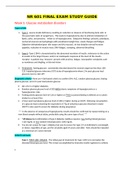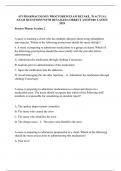Other
NR 601 Final Exam Study Guide (Version-2) / NR601 Final Exam Study Guide (NEWEST, 2021): Chamberlain College Of Nursing
- Course
- Institution
NR 601 Final Exam Study Guide (Version-2) / NR601 Final Exam Study Guide (NEWEST, 2021): Chamberlain College Of Nursing
[Show more]





